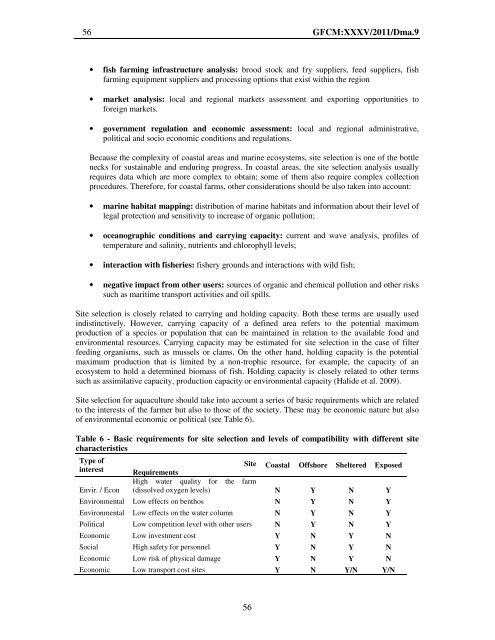Site selection and carrying capacity in Mediterranean ... - FAO Sipam
Site selection and carrying capacity in Mediterranean ... - FAO Sipam
Site selection and carrying capacity in Mediterranean ... - FAO Sipam
Create successful ePaper yourself
Turn your PDF publications into a flip-book with our unique Google optimized e-Paper software.
56 GFCM:XXXV/2011/Dma.9<br />
• fish farm<strong>in</strong>g <strong>in</strong>frastructure analysis: brood stock <strong>and</strong> fry suppliers, feed suppliers, fish<br />
farm<strong>in</strong>g equipment suppliers <strong>and</strong> process<strong>in</strong>g options that exist with<strong>in</strong> the region<br />
• market analysis: local <strong>and</strong> regional markets assessment <strong>and</strong> export<strong>in</strong>g opportunities to<br />
foreign markets.<br />
• government regulation <strong>and</strong> economic assessment: local <strong>and</strong> regional adm<strong>in</strong>istrative,<br />
political <strong>and</strong> socio economic conditions <strong>and</strong> regulations.<br />
Because the complexity of coastal areas <strong>and</strong> mar<strong>in</strong>e ecosystems, site <strong>selection</strong> is one of the bottle<br />
necks for susta<strong>in</strong>able <strong>and</strong> endur<strong>in</strong>g progress. In coastal areas, the site <strong>selection</strong> analysis usually<br />
requires data which are more complex to obta<strong>in</strong>; some of them also require complex collection<br />
procedures. Therefore, for coastal farms, other considerations should be also taken <strong>in</strong>to account:<br />
• mar<strong>in</strong>e habitat mapp<strong>in</strong>g: distribution of mar<strong>in</strong>e habitats <strong>and</strong> <strong>in</strong>formation about their level of<br />
legal protection <strong>and</strong> sensitivity to <strong>in</strong>crease of organic pollution;<br />
• oceanographic conditions <strong>and</strong> <strong>carry<strong>in</strong>g</strong> <strong>capacity</strong>: current <strong>and</strong> wave analysis, profiles of<br />
temperature <strong>and</strong> sal<strong>in</strong>ity, nutrients <strong>and</strong> chlorophyll levels;<br />
• <strong>in</strong>teraction with fisheries: fishery grounds <strong>and</strong> <strong>in</strong>teractions with wild fish;<br />
• negative impact from other users: sources of organic <strong>and</strong> chemical pollution <strong>and</strong> other risks<br />
such as maritime transport activities <strong>and</strong> oil spills.<br />
<strong>Site</strong> <strong>selection</strong> is closely related to <strong>carry<strong>in</strong>g</strong> <strong>and</strong> hold<strong>in</strong>g <strong>capacity</strong>. Both these terms are usually used<br />
<strong>in</strong>dist<strong>in</strong>ctively. However, <strong>carry<strong>in</strong>g</strong> <strong>capacity</strong> of a def<strong>in</strong>ed area refers to the potential maximum<br />
production of a species or population that can be ma<strong>in</strong>ta<strong>in</strong>ed <strong>in</strong> relation to the available food <strong>and</strong><br />
environmental resources. Carry<strong>in</strong>g <strong>capacity</strong> may be estimated for site <strong>selection</strong> <strong>in</strong> the case of filter<br />
feed<strong>in</strong>g organisms, such as mussels or clams. On the other h<strong>and</strong>, hold<strong>in</strong>g <strong>capacity</strong> is the potential<br />
maximum production that is limited by a non-trophic resource, for example, the <strong>capacity</strong> of an<br />
ecosystem to hold a determ<strong>in</strong>ed biomass of fish. Hold<strong>in</strong>g <strong>capacity</strong> is closely related to other terms<br />
such as assimilative <strong>capacity</strong>, production <strong>capacity</strong> or environmental <strong>capacity</strong> (Halide et al. 2009).<br />
<strong>Site</strong> <strong>selection</strong> for aquaculture should take <strong>in</strong>to account a series of basic requirements which are related<br />
to the <strong>in</strong>terests of the farmer but also to those of the society. These may be economic nature but also<br />
of environmental economic or political (see Table 6).<br />
Table 6 - Basic requirements for site <strong>selection</strong> <strong>and</strong> levels of compatibility with different site<br />
characteristics<br />
Type of<br />
<strong>in</strong>terest<br />
Envir. / Econ<br />
Requirements<br />
<strong>Site</strong> Coastal Offshore Sheltered Exposed<br />
High water quality for the farm<br />
(dissolved oxygen levels) N Y N Y<br />
Environmental Low effects on benthos N Y N Y<br />
Environmental Low effects on the water column N Y N Y<br />
Political Low competition level with other users N Y N Y<br />
Economic Low <strong>in</strong>vestment cost Y N Y N<br />
Social High safety for personnel Y N Y N<br />
Economic Low risk of physical damage Y N Y N<br />
Economic Low transport cost sites Y N Y/N Y/N<br />
56
















